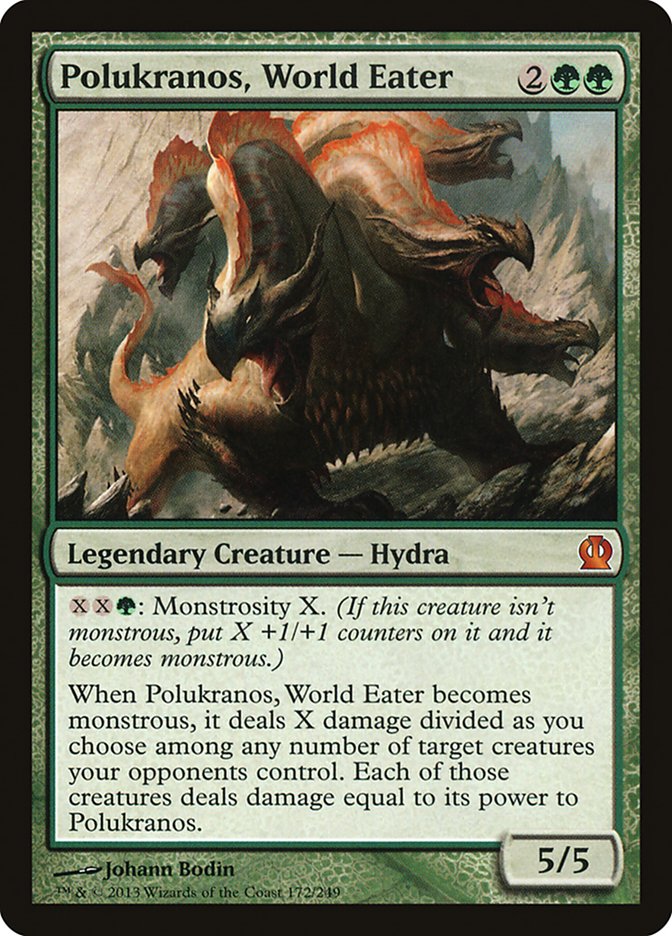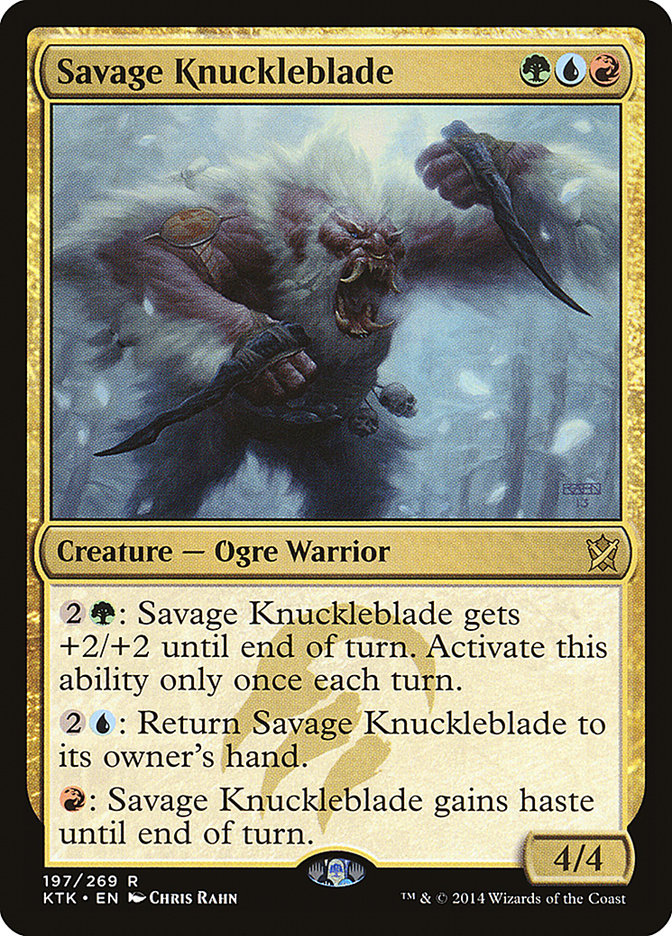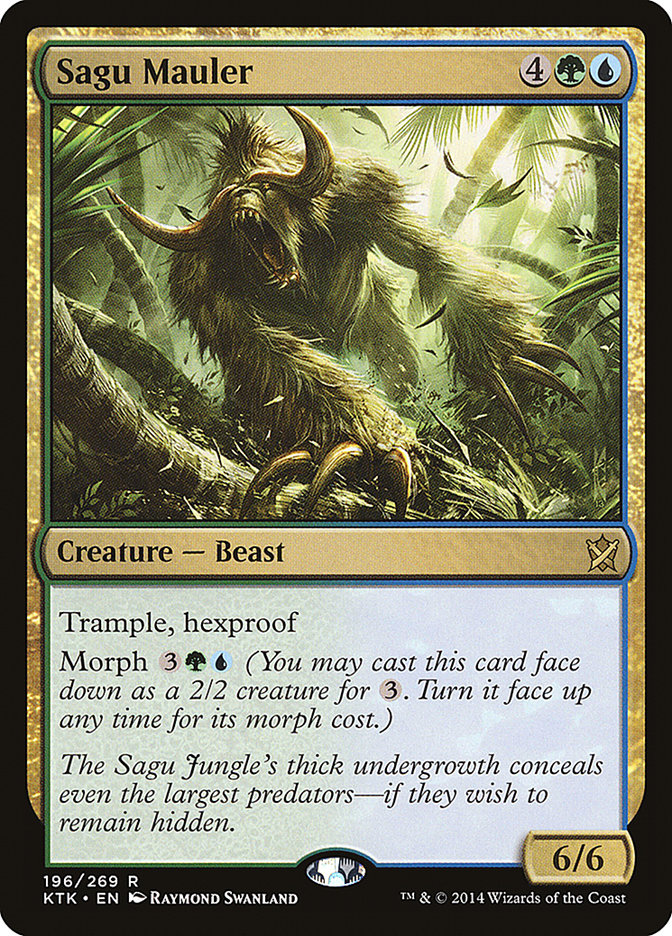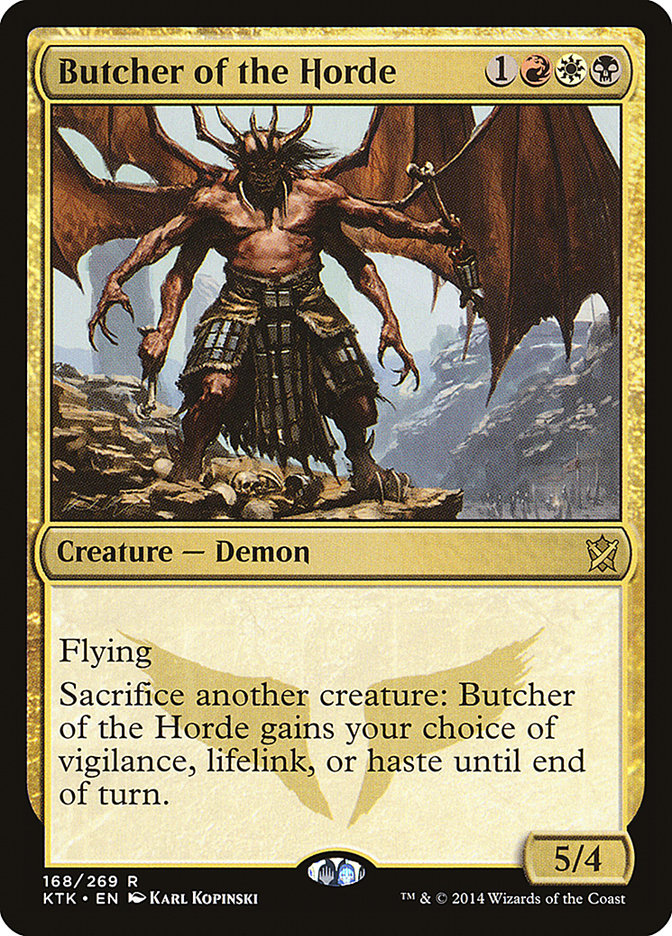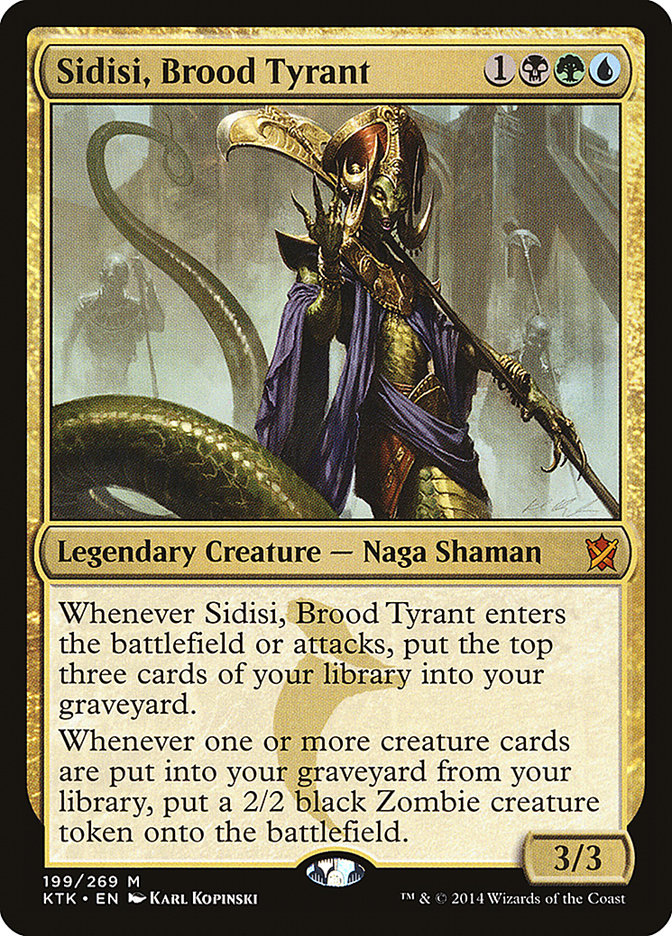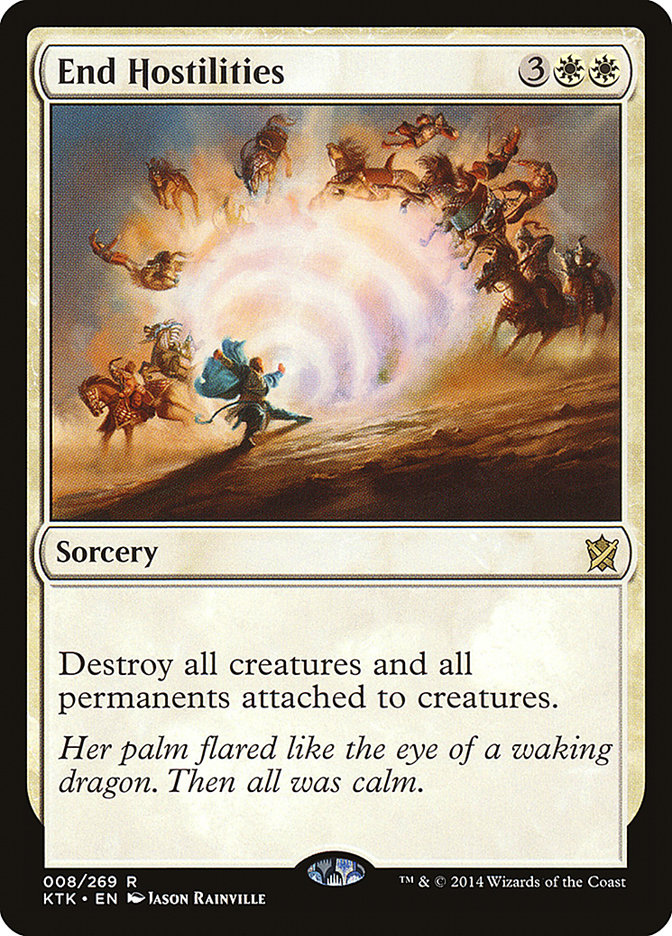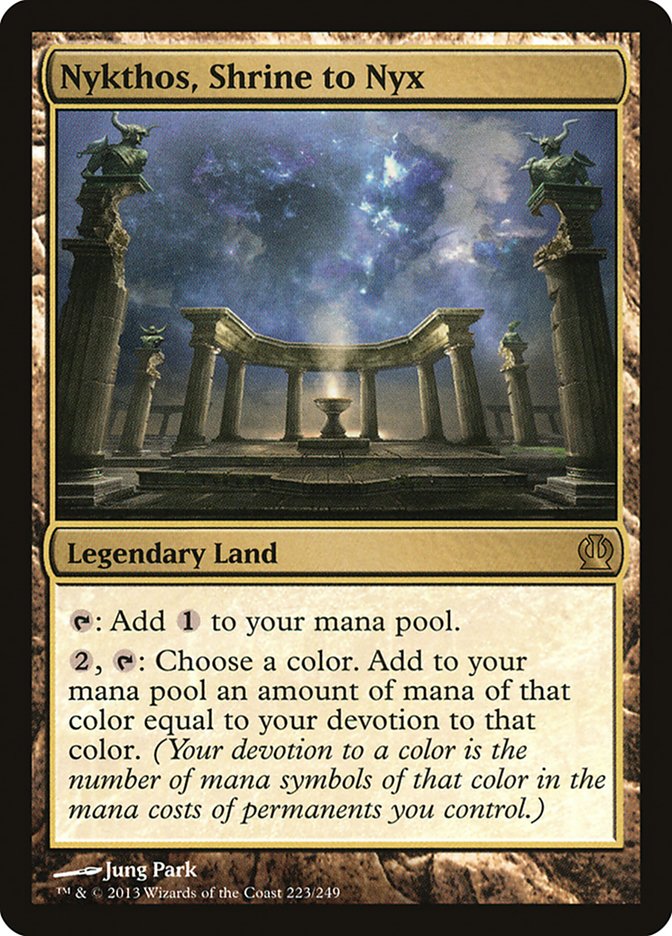I have a section in my phone that’s dedicated to notes and scraps of anything and everything regarding Magic. Competitive, Commander, Modern, player
etiquette, tells. You name it, it’s probably in there. Some of these:
– Maindeck Blood Moon in Sneak and Show; cheap crutch, free-win potential, but might be overkill
.
–
Jeskai Twin post
-Khans, Geist of Saint Traft sideboard plan;
mana is much better, and Mana Tithe is good in a format that’s slowing down
.
–
Jeskai Auras
. Swapping Rancor and Unflinching Courage for Madcap Skills and Furor of the Bitten
with potential Thundermaw Hellkite in sideboard. Good if mono-
Abzan Reanimator.
– Goblin Rabblemaster in U/R Delver; powerful with Vapor Snag. Functional Geist on the top end. Gets rid of need for Batterskull and the like.
– Using Wild Nacatl with as few colors as possible; addresses inherent weakness of Zoo, adds more sturdiness and stability.
– Opponent draws a card and immediately plays a land with multiple cards in hand, but doesn’t take an action/tanks
. Likely drew a land, indirect tell of flooding.
Keeping these kinds of notes are a great way for me to keep my ever racing mind going without losing anything. I’m constantly having things pop up in my
head, but without a platform to facilitate these ideas, many potential strategies can easily be lost. Every new set that gets released exponentially
increases the amount of things I jot down. Sure, some of the ideas won’t work or are bad, but does it really matter how good or bad an idea is if the idea
isn’t implemented in the first place? Most good decks “seem bad” to players not willing to open their mind up initially.
Part of all this is why I love working with new cards, new interactions, and new mechanics. As much as I’ll miss this previous Standard, I certainly
welcome our new friends. Khans of Tarkir is an interesting one because all of the cards look amazing! I want to play every single color! While it isn’t
outside of the realm of possibility, I don’t think I’ll be willing to go that deep…yet.
The first thing I look for when it comes to working on a new set is the cards that fit best with my playstyle. Since I tend to gravitate toward
aggressively costed large creatures and aggressive midrange strategies, I’ll try and find cards that resonate with that strategy. I try and stay away from
directly comparing cards to each other, because it’s one of the quickest ways of sabotaging a solid thought process. That said, the bar for such a strategy
is incredibly high, and it’s going to be very difficult to match or surpass what this bad boy brings to the table:
Polukranos, World Eater is the benchmark of what a midrange creature will be, on both offense and defense. There aren’t very many creatures in Khans of
Tarkir that can unconditionally match Polukranos. That isn’t to say that those creatures aren’t playable, but it does mean that I need a very good reason
to play them. As we all know, it just so happens that Polukranos can be played in our Courser of Kruphix and Sylvan Caryatid decks, so that shell is
already there and is pretty darn good as a baseline. This kind of starting point is the reason why I’m not incredibly high on a lot of the powerful green
based multicolored creatures as much. That said, playing these multicolored creatures alongside Polukranos can mean some super powerful decks on the top
end, and of course, the big creatures that aren’t green also get some love.
Let’s start with Savage Knuckleblade.
This card has been praised across the board, and for good reason. It’s aggressively costed, has a large body, and is a mana sink. The fact that it can come
down early, before any premier four drop, is huge; alongside being powerful if you draw it on turn 4, 5, 6, or even 10. It’s strong at all points of the
game, and it’ll take some real strain on the format as a whole for me to not play this card in some form. This is the epitome of what I look for in a
midrange structure.
My vote for sleeper of the set, Sagu Mauler is great on the low and high end, especially when curving out, of course. Hexproof has proven time and time
again that it’s an ability that can and will give headaches, and this card, in all its simplistic design, can be incredibly scary and out of nowhere. If
I’m going to play a Temur deck, then I’m going to want this at my top end for sure.
If I’m going non-green, then Butcher of the Horde is my first stop. Comparing this to Falkenrath Aristocrat (like any other comparison to a card that isn’t
accessible in Standard) is foolish, but the power level is through the roof on all fronts here. It’ll take a lot for me to move away from accelerating into
the big game of green decks, but Mardu is most certainly something I’m partial to. What I enjoy most about Butcher is how good it is at racing, and how it
makes the already powerful Mardu Charm even more absurd.
Of course, we can’t forget about the cards that we have from Theros Block as well. The biggest question for me regarding the block is where the multicolor
gods will end up? They largely weren’t a factor for most of last year, but regardless of if that changes or not, I know that players will want them to
work, and one of my first rules of preparing for a new format is that what you think other players think will be good matters much, much
more than what you think will be good.
Of course, there’s always the “aggro factor”. Just how aggressive and punishing can the aggro decks be on day one? Remember, it doesn’t matter how good we
think these decks are, especially if we’re on the receiving end of taking a million damage and being unprepared for them. Additionally, it’s very easy to
say “just slap some Anger of the Gods or Drown in Sorrow in your sideboard and that’s game!” Until you actually have to face things like two Mogis’s
Marauders bestowed on two different creatures, putting said creatures at four toughness, or Titan’s Strength putting their Rabblemaster out of Drown in
Sorrow range and easily defeating you thereafter. There is no such thing as a single answer to a deck, and if there is, then act like there isn’t. How many
times are you going to get your butt kicked by a red deck before you realize that trying to come up with this illogical way of thinking, then complaining
about it when it doesn’t work isn’t the way to go about things? Let’s look at it reasonably:
If the most aggressive deck on day one, whether it be Mono-Red, Mono-Black, or what have you, gets as low to the ground as possible, then there’s a lot of
merit in just playing sturdy creatures and holding the fort. Polukranos, World Eater is very good at doing this for a bit, as are cards like Wingmate Roc,
Butcher of the Horde, Siege Rhino, and Courser of Kruphix. Falter effects throw a big wrench in this plan, and force you to plan with that in mind. Adding
to these layers of offense, aggressive decks these days are also full of potential tricks that can blow a game wide open, and if you get caught in one of
those tricks, the game ends.
Done. Over. “Ded.”
Defending against aggressive decks is much less about having an “I win” button, and more about pressing a series of “Stop right there!” buttons at the time
they press their “I’m gonna get ya!” button. Sure, there will be games where said proverbials can turn into “I win,” but that’s not something we’re trying
to rely on that much. The conflict lies in finding the medium. You want things that are at least somewhat effective against both ends of the spectrum if
you’re midranging. If I were looking to build something that’s very sturdy against these types of aggressive decks while also executing a powerful midrange
gameplan that can outvalue other midrange plans, then Sultai is exactly where I want to be. Think about it for a second. All of the most talked about power
cards and power plays are pretty much the same plan, right? Sure, it may look different; exchanging a Savage Knuckleblade for a planeswalker, or a
Stormbreath Dragon for a Sarkhan, but on the surface, we’re all trying to midrange. Sultai utilizes its resources better than any of the other midrange
green combinations, and Sidisi, Brood Tyrant might secretly be one of the more powerful cards in the set because of that.
Lastly, I want to touch on control decks a bit. I think that the notion that you shouldn’t play control in a brand new format because you don’t know what
you’re controlling is a bunch of nonsense. That’s like saying you can’t build an aggro deck because you don’t know what you’re attacking. I don’t know
about anyone else, but in both cases, I know exactly what I’m attacking, and what I’m controlling.
You.
That said, control is going to have to go through a massive change now that it can’t lean on Sphinx’s Revelation and Supreme Verdict to clear things up.
End Hostilities is a very good start, but we’re certainly going to need more than that. Maybe the traditional definition of control is going to have to
change. Maybe we need to do something similar to the plan against aggro and not try to invest so much on trumps, and focus more on actually formulating a
series of dynamic, micro-gameplans that correspond to the strengths of the best available control cards. Maybe control decks will have to be centered
around creatures a bit more. Soul of Ravnica is incredible at out-carding (obviously), and out-grinding an opponent. Kiora, the Crashing Wave can help as
well if it isn’t being blown up by a Stormbreath Dragon or Sarkhan, the Dragonspeaker. Utter End and Hero’s Downfall are still good at handling those if
need be, as is Banishing Light. Narset, Enlightened Master is an absolute bomb that’s also respectable on the ground defensively. Is Geraro Fabiano’s
mascot, Ashiok, Nightmare Weaver more powerful now that the pressure of Pack Rat, and an overall known metagame aren’t an issue anymore? The card draw is
certainly there, with Dig Through Time being the frontrunner, along with Jace’s Ingenuity, Divination, and Read the Bones. Removal and counterspells are
all pretty plentiful, with Dissolve and Hero’s Downfall being the most powerful unconditional ones, and a pretty solid amount of cheaper, conditional
forms. Does this put the pieces together? Possibly, but that’s for you guys to find out.
Lastly, there’s devotion-based decks. Nykthos, Shrine to Nyx is way too powerful of a card to simply not be worked on, and this is the direction that I
think the aforementioned multicolored gods may take. Green Devotion looks to be the at the forefront from the discussions I’ve seen, as Reid Duke made that
clear at the Season Three Invitational last month. The pieces are mostly there, and Genesis Hydra, the real power card of the deck, is so powerful on its
own that you can form a gameplan around that before anything. Are the pieces for other colors there? It’s tough, with only Eidolon of the Great Revel
providing RR, and Prophetic Flamespeaker at the three for red, but maybe Heliod, God of the Sun can push through. The great thing about Heliod is that you
don’t necessarily need him turned on for him to be effective, but the cards that you do use to turn him on are complete beatsticks on their own:
Brimaz, King of Oreskos, Wingmate Roc, and Eidolon of Countless Battles, among others. Black Devotion can probably exist, but not in the same manner as it
did previously. Gray Merchant of Asphodel is still an absurdly powerful card, and powering it out with Nykthos may not be the worst idea, especially with
things like Liliana Vess providing the fuel.
So, what does this mean for the dual Open Series weekend in Indy and New Jersey? Who knows! There are so many amazing cards, I’d be very surprised if
things took a while to develop, but I know for sure that there will be a ton of different ways to go about things. I’ve looked at every single card in this
Standard format extensively, and we’re going to be in for an exciting ride in a couple of weeks.


